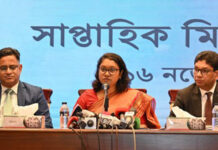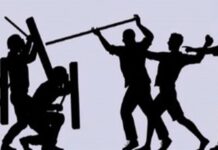
Two officials from the US embassy in Dhaka visited the headquarters of the Chittagong-based radical group Hifazat-e Islam on Wednesday and held an over two-hour-long meeting with seven of its top leaders.
The organisation in a media release said the meeting took place from 10am to 12:30pm at its office situated at the Hathazari Madrasa.
After the meeting, the officials from the American embassy – political officer Kathleen Gibilisco and assistant political specialist Lubain Chowdhury Masum – visited the premises of Hathazari Madrasa, hostels and the campus.
But Hifazat chief Shah Ahmad Shafi was not present at the time as he was out to attend a function, the release said.
Secretary General Zunaid Babu Nagari, leaders Anas Madani, Mainuddin Ruhi, Azizul Haque Islamabadi, Habibullah Azadi, Mujammel Haque and Shafi’s press secretary Munir Ahmed were in the meeting.
An official of the Australian High Commission in Dhaka had visited a madrasa run by a Hifazat leader in the port city’s Lalkhan Bazar last year. Later, crude bombs had exploded in a residential hall inside that madrasa.
This is the first time any US embassy official visited the madrasa at Hathazari after the government crackdown on a Hifazat rally on May 5 last year at Dhaka’s Motijheel following widespread violence unleashed by the activists of the radical group.
The media statement on Wednesday said the US embassy officials during the meeting wanted to know about Hifazat’s 13-point demands, organisational activities and the events of May 5.
Hifazat took to the streets in February last year with its 13-point charter of demand after youths and bloggers led a popular uprising in Shahbagh demanding maximum punishment to all 1971 war criminals.
Perceived to be funded by the Jamaat-e-Islami, Hifazat leaders had termed the Shahbagh movement a ‘movement of atheist bloggers’.
When the US officials asked about their position regarding the burning of the Quran, terrorism and militancy, Hifazat leaders told them that their organisation did not tolerate any offence to Allah, the Prophet and Islam and did not support attacks on the minorities, the release said.
It said they assured the officials that Hifazat would not be involved in any political activities.
The Hifazat leaders had asked about the US government’s view on Bangladesh’s Ulama-Mashayekh, Kaomi madrasas and their organisation. But Kathleen Gibilisco refused to say anything without permission from the higher authority, said the release.
Source: Bd news24










‘………..on May 5 last year at Dhaka’s Motijheel following widespread violence unleashed by the activists of the radical group.’ Is this fact? On the contrary, we all saw Hefazat activists could not cross beyond the Dainik Bangla crossing to approach near the National Mosque due to heavy police tear gas, water cannon etc . We saw about a hundred helpless terrified people huddling in line along the eastern wall by the stairs on the north. More interestingly, the burnt copies of the Holy Book, the sawed down trees were shown but who did that and how, no video was available though the detailed pictures after the rampage were shown. Question is: the sawing down of so many trees could not happen in a few minutes. It must have taken no less than an hour and that too in the ‘black-out’. Where were the law & order forces then? We also saw how young people in caps and long kurtas coming to the Hefazat assemblage were mercilessly beaten with sticks and kicked by 10/15 young men (one perhaps was a young Amazon) around the Gulistan crossing and outside the south gate of Baitul Mukarram. On the street by the north gate, a Hefazat supporter was seen lying unconscious, one was being carried by 2/3 men maybe to the hospital. But those did not come in most TV channels. We have seldom seen, not even during the ‘autocratic’ rules, such bizarre pictures of brutality. But we have nothing to say; because we are in a special type of democracy in which ‘the king can do no wrong’.